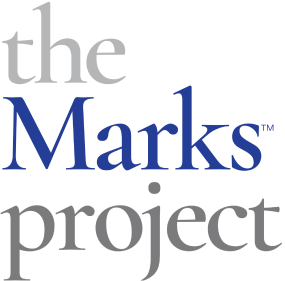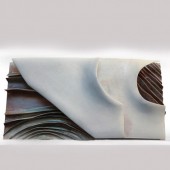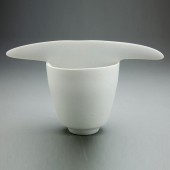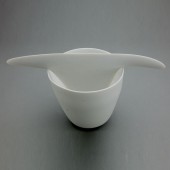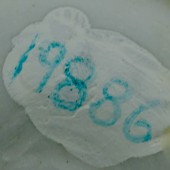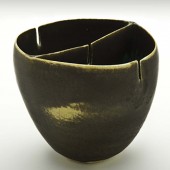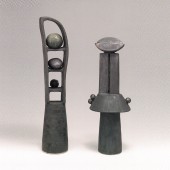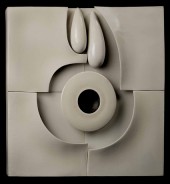![]() Printer version
Printer version
Ruth Duckworth
1919Born Hamburg, Germany
2009Died Chicago, Illinois
1936Immigrated to England
1966Immigrated to the United States
EDUCATION
1936-1940Drawing, Painting and Sculpture, Liverpool School of Art, Liverpool, England
1955Ceramics, Hammersmith School of Art, the City and Guilds of London Art School, London, England
1956-1958Ceramic Art, Central School of Arts and Crafts, London, England
1982Honorary Doctorate, DePaul University, Chicago, Illinois
2007Honorary Doctorate, College of Creative Studies, Detroit, Michigan
PRIMARY WORK EXPERIENCE
1959-1964Faculty, Central School of Arts and Crafts, London, England
1964-1977Faculty, Department of Arts, University of Chicago, Chicago, Illinois
1965Visiting Artist, Corsham School of Art, Corsham, Wiltshire, England
1969Summer Faculty, School of the Art Institute of Chicago, Chicago, Illinois
BIOGRAPHY
Ruth Duckworth is best known as a modernist sculptor who worked in stoneware and porcelain, creating hand-built, minimalist, abstract organic forms.
Duckworth created a place for clay as a sculptural medium at a time when it was not a widely accepted. As her career developed her work became increasingly minimal. She is most well-known for the ultra-smooth, unglazed, white porcelain surfaces of her work; however, she occasionally added stains of ceramic oxides. Later in her life she began to cast forms in bronze.
In 1936, at the age of 16, Duckworth, barred with all Jews from attending university, left Germany for Liverpool, England. In England she moved through many jobs gaining a myriad of experiences. She carved wooden puppet heads, grave stone, and made molds for Lucie Rie’s ceramic button business.
At Rie’s studio, Duckworth met ceramist Hans Coper who was also involved with making buttons. She met sculptors Jacob Epstein and Henry Moore who encouraged her work. By the 1950s Duckworth was working in lead and bronze, welded and cast, as well as in wood.
In 1955 Rie suggested that Duckworth return to school to learn more about pottery. Duckworth first enrolled at the Hammersmith School of Art. At the time, Hammersmith's ceramic curriculum was committed to the philosophy of Bernard Leach, honoring the traditions of the potter’s wheel, clay and the vessel form.
Duckworth quickly moved to the progressive Central School where she was taught by Dora Billington to slip cast and work with porcelain. The Central School was home to Gilbert Harding-Green, Ian Auld, Gordon Baldwin, Gillian Lowndes, Bill Newland and Dan Arbeid, among others. In the early 1960s Duckworth had her first one woman show at Henry Rothschild’s Primavera Gallery and her work was seen and appreciated as a new and innovative approach to clay. In the early 1960s she set up her first studio and bought her first electric kiln using German government compensation for the denial of education in 1936. Duckworth became a master at coil building stoneware sculptural forms and during this period she began to experiment with porcelain.
In 1966 Duckworth moved to the United States to teach at the University of Chicago and continued there until her retirement in 1977. She received her first major architectural commission and created the monumental four-hundred-square-foot stoneware mural, Earth, Water and Sky (1967-1968) at the University's Geophysical Science Building. This was followed by Clouds Over Lake Michigan (1976) for German Dresner Bank (Chicago), now reinstalled in the Chicago Board of Options Exchange. In 2023 this mural was acquired by the University of Chicago, Chicago, Illinois and is installed in the first-floor reading room of its Joseph Regenstein Library.
An interview with Ruth Duckworth conducted April 27, 2001 by Kenneth Trapp, for the Archives of American Art's Nanette L. Laitman Documentation Project for Craft and Decorative Arts in America is available at:
http://www.aaa.si.edu/collections/interviews/oral-history-interview-ruth-duckworth-12764.
PUBLIC COLLECTIONS
Alfred Ceramic Art Museum, Alfred University, Alfred, New York
Art Institute of Chicago, Chicago, Illinois
Buckingham County Museum, Buckinghamshire, England
City Museum, Bassano Del Grappa, Italy
Everson Museum of Art, Syracuse, New York
Fine Arts Museums of San Francisco, Legion of Honor, San Francisco, California
Gardiner Museum of Ceramic Art, Toronto, Canada
Houston Museum of Contemporary Art, Houston, Texas
Inner London Education Committee Collection, London, England
J.S. Speed Art Museum, Louisville, Kentucky
Kestner Museum, Hannover, Germany
Los Angeles County Museum of Art (LACMA), Los Angeles, California
Metropolitan Museum of Art, New York, New York
Mills College, Oakland, California
Museum Boijmans Van Beuningen, Rotterdam, the Netherlands
Museum fur Kunst und Gewerbe, Hamburg, Germany
Museum für Zeitgenössische Keramische Kunst, Frechen, Germany
Museum für Modern Keramik, Deidesheim, Germany
Museum of Arts and Design, New York, New York
Museum of Contemporary Art, Chicago, Illinois
Museum of Fine Arts, Boston, Massachusetts
Museum of Fine Arts, Houston, Texas
Museum voor Hedendaagse Kunst, 's-Hertogenbosch, the Netherlands
National Museum of Modern Art, Tokyo, Japan
National Museum of Scotland, Edinburgh, Scotland
Nelson-Atkins Museum of Art, Kansas City, Missouri
Philadelphia Museum of Art, Philadelphia, Pennsylvania
Racine Art Museum, Racine, Wisconsin
Saint Louis Art Museum, St. Louis, Missouri
Schleswig-Holsteinisches Landesmuseum, Schloss Gottorf, Germany
Smart Museum of Art, University of Chicago, Chicago, Illinois
Smithsonian American Art Museum, Renwick Gallery, Washington D.C.
Stedelijk Museum, Amsterdam, the Netherlands
Stuttgart Museum, Stuttgart, Germany
Ulster Museum, Belfast, Northern Ireland
Utah Museum of Art, Salt Lake City, Utah
Victoria and Albert Museum, London, England
Windsor Castle, Windsor, England
Wins Württembergisches Landesmuseum, Stuttgart, Germany
Yale University Art Gallery, New Haven, Connecticut
York Museums Trust, York, England
BIBLIOGRAPHY
Clark, Garth and Margie Hughto. A Century of Ceramics in the United States, 1878-1978. New York, NY: E.P. Dutton, 1979.
Clark, Garth and Cindy Strauss. Shifting Paradigms in Contemporary Ceramics The Garth Clark & Mark Del Vecchio Collection. New Haven, CT: Yale University Press, 2012.
Dietz, Ulysses Grant. Great Pots Contemporary Ceramics from Function to Fantasy. Madison, WI: Guild Publishing, 2003.
Donato, Debora Duez. Ruth Duckworth and Martyl: Paintings, Drawings, and Sculpture. State of Illinois Art Gallery, 1990.
Duckworth, Ruth. Ruth Duckworth at 80. New York, NY: Garth Clark Gallery, 1999.
Lauria, Jo and Tony Birks. Ruth Duckworth: Modernist Sculpture. London, England: Lund Humphries, 2005.
Levin, Elaine. The History of American Ceramics: From Pipkins and Bean Pots to Contemporary Forms, 1607 to the Present. New York, NY: Harry N. Abrams, Inc., 1988.
Lynn, Martha Drexler. Clay Today Contemporary Ceramists and Their Work A Catalogue of the Howard and Gwen Laurie Smits Collection at the Los Angeles County Art Museum. Los Angeles, CA: Chronicle Books, 1990.
CV or RESUME: Click Here to Download
CV or RESUME: Click Here to Download
Source: Elaine Levin Archive, University of Southern California
Method: Hand-Built
Dimensions: 31 1⁄2 x 30 x 8 in. (80.0 x 76.2 x 20.3 cm) Surface Technique: Glaze, Slip
Method: Hand-Built
Dimensions: 6 1⁄2 x 21 in. (16.5 x 53.3 cm.) diam.Surface Technique: Glaze
Method: Hand-Built
Dimensions: 18 x 18 3⁄8 x 5 1⁄2 in. (45.7 x 46.7 x 14.0 cm) Surface Technique: Glaze
Citation: "The Marks Project." Last modified August 23, 2025. http://www.themarksproject.org:443/marks/duckworth
